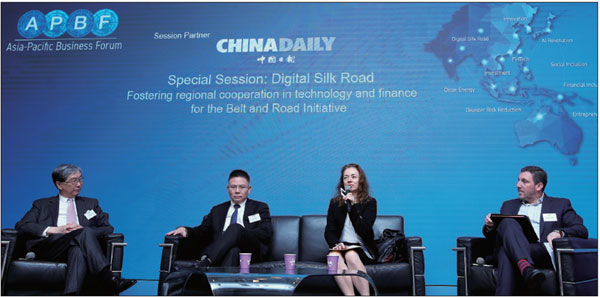The digital connection down the Silk Road
Updated: 2018-04-12 07:21
By David Ho(HK Edition)
|
|||||||
Financial experts say digitalization will be a key pillar of the Belt and Road Initiative, calling for barriers to be removed through modern tech
The significance of the digital connection in the China-led Belt and Road Initiative came into sharp focus on Wednesday as pundits deliberated on the new concept in exploring deeper regional economic cooperation among the Belt and Road countries.
At a special session co-organized by China Daily and the Asia-Pacific Business Forum, which was held in Hong Kong for the first time, panelists harped on the advent of the digital age and development as the vital link for infrastructure building in countries and regions along the Belt and Road.
"The Belt and Road has been one of the key topics we've covered in our publications and discussed at our roundtable events. This session is special because it focuses on the Digital Silk Road," said Zhou Li, editorial board member of China Daily Group and publisher and editor-in-chief of China Daily Asia Pacific, in remarks at the session themed "Digital Silk Road: Fostering Regional Cooperation in Technology and Finance for the Belt and Road Initiative".
Zhou, who had just returned from the 2018 Boao Forum for Asia, recounted President Xi Jinping's keynote address at the Boao conference on Tuesday, in which the president stressed that the Belt and Road may be China's idea, but the opportunities and outcome are for the world.

The digital connection in the region, sparked by the initiative, is just as vital in linking it as the vast infrastructure building required. Xi had proposed constructing the Digital Silk Road of the 21st Century at the Belt and Road Forum for International Cooperation held in Beijing in May last year.
Li Shan, chief executive officer of Silk Road Finance Corporation, pointed out that the Digital Silk Road is just an evolution of a historical concept.
"The Belt and Road is based on the legendary history of the Silk Road. But now, we are trading more than silk and no longer using camels. Rather, we are using fintech to digitize modern finance," Li said at the panel discussion.
Carson Wen, founder and chairman of Bank of Asia, British Virgin Islands and BOA Financial Group, reminded the audience that digital development is one of the pillars of the Belt and Road Initiative.
"There are over 2 billion people with phones but no bank accounts. This is a chance for financial inclusion for everyone," he said.
"The initiative covers more than 65 countries and counting. We need to figure how to remove the barriers between them through the use of modern tech," Li chipped in.
But, that could be a problem as the digitization gap remains wide, both within China itself and the region.
Margit Molnar, chief China economist for the Organization for Economic Co-operation and Development, cited smart manufacturing (defined as when more than half of the manufacturing process is digitized) as an example of that gap.
Her study on smart manufacturing in China found there was significant room for growth in the western part of the country, with less than 9 percent of companies adopting it in provinces ranging from Jiangsu in eastern-central China to Yunnan in the far southwest.
Molnar pointed there're a few challenges in changing that.
"Firstly, the layout of infrastructure is very costly. From my understanding, three of the major mobile network companies in China are investing about $180 billion in optical fiber for 5G connections," she said, while acknowledging that the Belt and Road Initiative could play a part in addressing that.
"Secondly, we need a regulatory framework that provides a consensus for taxes and covers the transfer of data in the networks as it grows," Molnar added. This could be likened to something like the European Union's General Data Protection Regulation, which will come into effect on May 25.
Li did point out the need for that regulation to be innovation friendly.
"Whether you are in the Silicon Valley or China, innovative solutions emerge quickly. The question is how established the regulatory frameworks are to handle them. Regulators need to be open minded enough to not hold back innovation," he said.
One of Li's suggestions for smoother cooperation among the Belt and Road countries and regions is the introduction of a single crypto-currency. But, he acknowledged the difficulties in moving that forward due to regulators' reluctance to take the potential risks.
Wen proposed the concept of a "sandbox" or a testing ground for regulators to get comfortable with the idea and sort out any possible teething issues.
Li reckoned that Hong Kong might be a good fit for testing out any financial innovations, given its strong background in this sector.
"China is celebrating four decades of success since its initial reform. Shenzhen was its initial 'sandbox' for its experiments in manufacturing and capitalism before. Hong Kong could step into the same role and reap the benefits of it," Li said.
Another issue Molnar raised is the need for talent to handle the digital side of things. Her study on skills among graduates found that the biggest deficiency was in computer programming. "That could be the biggest bottleneck in the plan for digitalization," she said.
Wen, however, said countries like the British Virgin Islands are already addressing that issue. "The Minister of Culture for the British Virgin Islands told me they will be introducing two new subjects in schools - Chinese language and coding. Coding is a subject that should be taught in many countries," he said.
Ultimately, Molnar said it's important to think of the Belt and Road as an ever evolving concept. "The countries covered and the scope of the initiative has changed and evolved with time," she said.
"When talking about the initiative, I always like to emphasize productivity and growth effect. Not just infrastructure that will add to capital stock. We need to talk more about the harmonization of cooperation in these areas too."
Meruyert Rysbekova, chief expert at the Department of Tech and Innovative Development, Ministry of Investments and Development of Kazakhstan, who also attended the panel discussion, summed it up as "crucial."
"Digitalization is everywhere now, from finance to every other thing. With more than 65 countries involved in the Belt and Road and varying levels of development between them, there are bound to be challenges and stumbling blocks ahead," she said.
"This is a digital world we're living in and it's important to remember that what we're discussing here is about the present, not just the future."
For China Daily
|
Distinguished panelists share their insights and opinions on the advent of the digital age and development as the vital link for infrastructure building in countries and regions along the Belt and Road at the Asia-Pacific Business Forum on Wednesday. PHOTOS BY PARKER ZHENG / CHINA DAILY |
(HK Edition 04/12/2018 page18)
